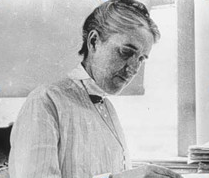- 1610: Galileo
- 1676: Ole Rømer
- 1687: Isaac Newton
- 1781: William Herschel
- 1838: Friedrich Bessel
- 1861: William and Margaret Huggins
- 1912: Henrietta Leavitt
- 1917 Einstein
- 1920: Harlow Shapley
- 1929 Edwin Hubble
- 1948: Ralph Alpher
- 1949: Fred Hoyle
- 1963: Maarten Schmidt
- 1964: Arno Penzias and Robert Wilson
- 1978: Vera Rubin and Kent Ford
- 1989: Margaret Geller and John Huchra
- 1992: John Mather and George Smoot
- 1995: Robert Williams
- 1998: Saul Perlmutter and Brian Schmidt
- 2010: Wendy Freedman
1912: Henrietta Leavitt Discovers the Distance Key
 |
| Henrietta Swan Leavitt. |
The parallax method used to measure the distances to nearby stars, pioneered by Bessel and others could only be used on stars closer than 100 light years away. But most stars and other galaxies are far beyond that distance. The key for finding the distance to stars much further away was discovered by Henrietta Swan Leavitt who worked at Harvard College Observatory as a “computer,” one of several women paid 25 to 30 cents per hour to extract data from thousands of photographic plates.
Unfortunately stars are not the same intrinsic brightness (or
luminosity), so it is impossible to tell if a star appears dim because it’s far away, or because it doesn’t put out much light. If only it were possible to determine the actual luminosity of a star, then its apparent brightness could be used to determine its distance from us.
Leavitt’s assignment was to identify variable stars, which are stars that change in brightness over a few hours, days, or weeks. To do this she would compare two photos of a star field taken a few days or weeks apart. She used an instrument called a blink comparator that flips back and forth quickly between the two images so that a variable star shows up as a flashing spot. With this method she found more than 2,400 variable stars.
Leavitt became curious about whether there might be a relationship between the brightness of a variable star and the length of its period (how long it takes for the star to get brighter, dimmer, then brighter again). That was difficult because she did not know the intrinsic brightness of any given variable. She solved the problem by restricting her search to a particular kind of variable star known as Cepheid variables that reside in the Small Magellanic Cloud—a distant star cluster. She reasoned that all stars in the cluster must be approximately the same distance from Earth.
 Her hunch paid off. Leavitt discovered 25 Cepheid variables in the cluster and created a graph showing the maximum brightness of each star and the length of its period. As she suspected, there was a clear relationship. Brighter stars had longer periods. All that was needed to find actual distances was to find the distance to just one nearby Cepheid variable. A few years later a team of astronomers did just that, making it possible to measure the distance to any Cepheid in just three steps:
Her hunch paid off. Leavitt discovered 25 Cepheid variables in the cluster and created a graph showing the maximum brightness of each star and the length of its period. As she suspected, there was a clear relationship. Brighter stars had longer periods. All that was needed to find actual distances was to find the distance to just one nearby Cepheid variable. A few years later a team of astronomers did just that, making it possible to measure the distance to any Cepheid in just three steps:
a) Measure the period of the star. b) Use Leavitt’s graph to determine how bright it really is. c) Measure how bright it appears and determine its distance.
By discovering the distance key, Henrietta Swan Leavitt made possible all of the subsequent discoveries in astronomy of the 19th and 20th centuries.